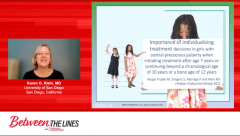
Vargas Trujillo CPP Study Review: Study Results
Karen O. Klein, MD, reviews data and study results from the Vargas Trujillo et al study on the importance of individualizing treatment decisions in girls with CPP.
Episodes in this series
Karen O. Klein, MD: Hello. My name’s Dr Karen Klein from the University of California San Diego in San Diego, California. And I will be discussing a Journal Club article today. The title is “Importance of individualizing treatment decisions in girls with central precocious puberty when initiating treatment after age 7 years or continuing beyond a chronological age of 10 years or a bone age of 12 years.” The first author is Dr Marcela Vargas Trujillo, one of my colleagues at the University of California San Diego. This program is sponsored by AbbVie. I need to disclose that the contents are consistent with all applicable FDA guidelines. I’ve been selected by AbbVie, and I’m presenting on their behalf.
The first figure in the paper looks at the change in bone age to chronological age ratio over time. As I mentioned, at baseline, it’s about 1.5—very advanced bone age ratio. And then it steadily decreases throughout treatment to about 1.2, and 1.1 by the end of treatment. Also importantly, 31% of the girls reached a point with a bone age less than a year beyond their chronological age. Growth velocity declined. I’m not showing that data. But it also declined appropriately from pubertal rates prior to treatment to prepubertal rates during treatment. Figure 2A is the change in predicted adult height during treatment, which continued to increase with longer duration of treatment. That’s also been previously shown. And then Figure 2B shows this unique distribution. But the change of predicted adult height during treatment was not based on the age that they started treatment. Now, we didn’t have as many that were younger, and you can see the younger girls had a great improvement in predicted adult height over baseline. But when we look at the girls who started at 7 and 8 years old, they also had many girls—and we’ll go through those details—who had significant changes in predicted adult height. Forty-five of the 48 girls has some increase. The line is drawn at 0. There’s a couple that didn’t increase in their predicted adult height during treatment. Figure 2C again shows us that change in predicted adult height, but with the solid dots representing the girls who were less than 7 years of age doing very well. And more than half of the girls who were greater than 7 years of age doing just as well with continued predicted adult height, irrespective of their chronological age at the start of treatment. Another way to summarize it is that predicted adult height increased in 91% of the girls who started treatment at a chronological age greater than or equal to 7 years of age. Forty-six percent of those who initiated greater than or equal to 7 years had at least a 5-centimeter cm increase in predicted adult height. And 16%, 6 of 37 girls, had greater than 10 cm increase in predicted adult height. The sample size was too small to reach statistical significance but makes the point that many girls continue to benefit. And not just 2- to 4-cm benefit, but greater than 5 or even 10 cm in some of the girls. Figure 2D again shows the change in predicted adult height, but by bone age. And you can see, even beyond a bone age of 12, there continues to be increases in predicted adult height. This table separates the girls who were less than 7 years of age at the start of treatment with those who were greater than or equal to 7 years of age at the start of treatment. The numbers are too small to reach statistical significance. But you can see similar numbers, proportionately, of those who achieved at least 5 cm of improvement or greater than 10 cm of improvement. Girls who initiated treatment at a chronological age less than 7 years and girls who initiated treatment at a chronological age greater than or equal to 7 years had comparable increases in predicted adult height during treatment and comparable final height. Table 3 compares those with a bone age less than 12 years to those with a bone age greater than or equal to 12. Eighty-four percent of our population in this study who continued treatment beyond a bone age of 12 continued to increase their predicted adult height. Not all, but most. The 3 girls who did not show improvement were either already at or near their midparental height, shown on the right side, and continued improvement of predicted adult height 1 year prior to near the end of treatment, at and then final height. Interestingly, in this study with girls who were treated longer, final height was close to that last assessment of predicted adult height. There are other studies published that show the risk of final height decreasing after the end of treatment, and our data suggests that might be based on stopping treatment too soon. Although we can’t directly conclude that from this study, I want you to notice that, in this study, where children were treated longer, they did reach those heights, on average. Thirty girls were followed to final height. I’ve already mentioned the key points of this figure. Sixteen girls had a decrease from their greatest predicted adult height. There is some loss of predicted adult height, but 58% reached or surpassed their midparental height.
Transcript Edited for Clarity
Newsletter
Access practical, evidence-based guidance to support better care for our youngest patients. Join our email list for the latest clinical updates.








